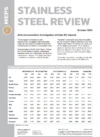Urgent recovery plan may boost EU stainless steel
Steel sector leaders were among senior industry figures representing 7.8 million EU workers who have called on the European Commission to stimulate the EU economy as a matter of urgency.
Almost 20 industrial sectors were represented by the 73 leaders who jointly proposed a 10-point recovery plan to Belgian prime minister Alexander De Croo and Commission president Ursula von der Leyen as part of ‘The Antwerp Declaration for a European Industrial Deal’.
The call for action came as the chief executives of European stainless steel producers Aperam and Outokumpu described the region’s trading conditions as “deeply depressed” and “challenging” while reporting their 2023 financial results.
Stainless steel producers’ results
Aperam chief executive Timoteo Di Maulo referred to the current economic situation in Europe as a “crisis” this month. The Luxembourg-based steelmaker’s 2023 annual financial revealed that the revenues from its stainless and electrical steel division had declined from EUR5.5 billion to EUR4.2bn last year as shipments declined from 1.60m to 1.55m tonnes.
Outokumpu’s 2023 deliveries were 9% down year-on-year, at 1.37m tonnes, meanwhile. Its revenues declined from EUR 9.49bn to EUR6.96bn as it suffered a net loss of EUR111m – down from a EUR1.09bn profit a year earlier. Chief executive Heikki Malinen said that the market had declined to its lowest point in quarter three last year, adding that recovery had been slow in the period since.
A report from Bundesbank suggests that Germany is now in recession. The UK, meanwhile, entered recession in February after a 0.1% decline in GDP from July to September was followed by a 0.3% contraction in quarter four.
During February’s research period, MEPS’s European respondents reported subdued trading activity. Elevated raw material costs and supply disruption served to maintain prices.
Growing need for EU recovery plan
The Antwerp Declaration calls for action to address the current economic downturn while supporting the transition to net zero. It urges the European Commission to: provide abundant and affordable low-carbon energy; scale up domestic mining, sustainable processing and recycling capacity for crucial raw materials; simplify state aid for high-emitting industries making the green transition; and provide stronger support for EU projects.
Many MEPS respondents highlight that reduced interest rates will signal the start of the upturn in economic growth required by the stainless steel sector. This is unlikely to happen until later in the year, following a period of stable inflation at reduced levels, however.
Like the industry leaders backing the Antwerp Declaration, others are hopeful of more definitive action to strengthen future trading conditions for European steelmakers. In February, an alliance of 11 German steelmaking states gave their backing to ongoing negotiations between the EU and the US over a Global Agreement on Sustainable Steel and Aluminium (GASSA). An agreement would aim to address the issue of overcapacity while encouraging the trade of low-carbon materials.
In conjunction with the EU’s carbon border adjustment mechanism (CBAM), such a measure would help protect EU steel producers from some cheaper overseas imports. This month’s MEPS research (see below) identifies a significant reduction in stainless steel imports into the EU during quarter one. Third-country material may yet prove to be less of a threat to the sector than a faltering economy.
- This content first appeared in the February edition of MEPS International's Stainless Steel Review. The monthly report provides subscribers with steel prices, indices, market commentary and forecasts from across the globe.

Source:
Stainless Steel Review
The MEPS Stainless Steel Review is an invaluable monthly guide to international stainless steel prices and includes the latest global stainless steel industry analysis.
Go to productRequest a free publication





